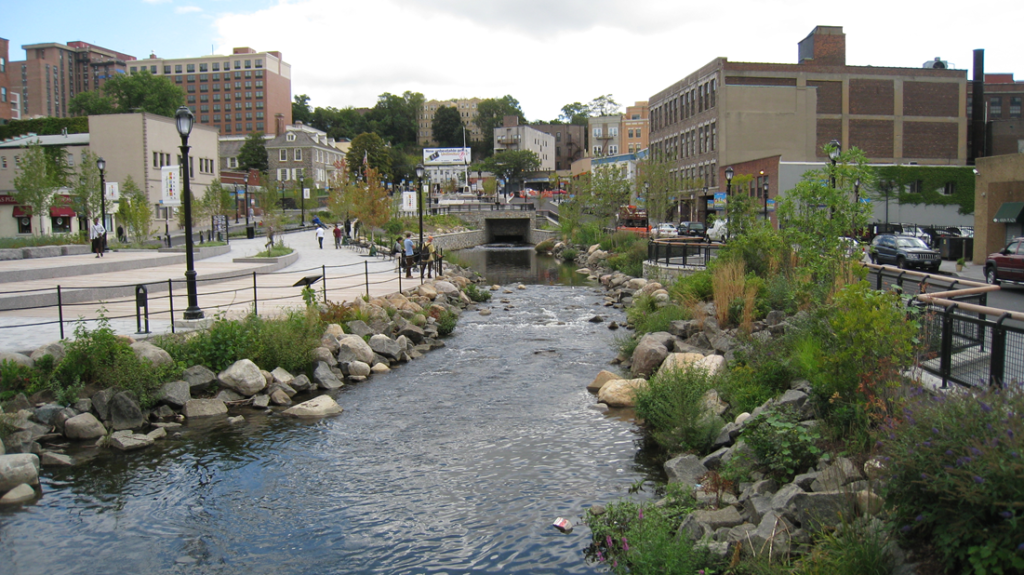This year, the team members of the Urban Waters Learning Network are digging deeper into a topic that has long been a concern of our members: the gentrification and displacement of people that we see taking place in our urban communities, oftentimes following efforts to revitalize and reinvest in the places we call home. We are addressing these topics by surveying our network members and by producing blog posts, webinars, impact stories, and other resources. The following is the first blog in a series focusing on anti-displacement (find the second blog post here).
Intention and attention. It’s been a new mantra for me in 2019. To set an intention is one thing, paying attention to how it manifests and what opportunities arise is another thing entirely. While I apply this mantra to the intentions I set in my own personal life, I also apply it to the work that I do here at the Urban Waters Learning Network (UWLN). This year, we are digging deeper into a topic that has been a concern of UWLN members for years: the gentrification and displacement of people that we see taking place in our urban communities, typically following efforts to revitalize and reinvest in the places we call home. This reinvestment can come in the form of the projects we pursue as part of our urban waters work.
As I set about this work, I create the intention to provide the best information that I possibly can while paying attention to the voices around me. And, those voices are strong and knowledgeable. Since I started working as a member of the UWLN team, I’ve had great conversations with many of the urban waters practitioners in our network. I’ve also learned a lot from the people that I work with. And, I hear what they are saying:
About neighborhoods in Altanta, Darryl Haddock from the West Atlanta Watershed Association shared “…houses are being foreclosed at $20,000-$30,000 and being flipped and sold for $300,000 or more.” This shift in real-estate price is happening in the same areas of Atlanta in which the city and other organizations have made investments in green infrastructure and community revitalization.
Ann-Marie Mitroff from Groundwork USA says this of the evolving impacts from daylighting the Saw Mill River in Yonkers, NY: “People wanted improvement—especially when there are derelict and empty buildings surrounding them; they want amenities and green space. But, they want to remain in their community and they see no one concerned about how housing or business rents and prices start going up and begin to squeeze them out.”
And, in reference to the major storm events that have affected the United states, Diana Toledo from the River Network summarizes, “In 2017, Hurricanes Harvey, Irma and Maria displaced over 3 million people in the space of a month. In 2016, Hurricane Matthew displaced 2.2 million. Ten years following Hurricane Katrina, nearly 100,000 residents had not returned to New Orleans. Related to the stories of displacement are the changes that neighborhoods experience following disaster recovery activities.”
If you are working on the ground in urban waters communities, at least one of these stories probably sounds very familiar. Our network is busy improving water quality, daylighting streams, creating green space and green infrastructure, implementing disaster recovery initiatives, and advocating for climate resilience plans. To want to remedy environmental injustice is the right work. We all, in fact, deserve to live in communities that are healthy, safe, and resilient.
Within these same communities, however, there is often a rational fear from residents that efforts at greening a community or redevelopment after a disaster are another form of “green gentrification” that will ultimately lead to changes in the character of the community, drive up the costs of living there, and attract real-estate investors and more affluent populations.
Does creating a healthy environment always have to lead to higher property values?
Members of the UWLN are keenly interested in better understanding this issue and their role in it. This year, UWLN team members are addressing your concerns (which are also our concerns) and looking for answers to the big question:
What policies can we advocate for as we revitalize communities made vulnerable by disinvestment so that our work doesn’t contribute to displacement pressures?
The answer is not singular, the solution not one-size-fits-all. It is clear, however, that placing EQUITY at the front and center of new development and investments is where it starts. After that, the equitable development and anti-displacement strategies you can pursue will depend on your institutional setting (i.e. non-profit, private business, or government) and the strength of your partnerships.
Through our research and conversations with policy experts, we identified four main anti-displacement strategies which may provide a helpful framework. They include (1) Housing, (2) Workforce Development, (3) Good Jobs, and (4) Democracy/Justice. We are working on putting together meaningful resources, case studies, and webinars pertaining to these strategies to share with you. Our intent is to bring you opportunities for learning and to help us all understand what role we play in this “gentrification-displacement” dynamic, while being attentive to the stories of others. In this way, we can make a difference not just environmentally but socially as well.
We are currently surveying the members of the UWLN to identify experts among us and to assess what needs exist for learning and networking around these topics. If you have an interest in or have resources pertaining to this topic, please reach out to us directly: Renee Mazurek (reneemaz@gmail.com) or Diana Toledo (dtoledo@rivernetwork.org).
Stay tuned for more information on this very important work!


Trackbacks/Pingbacks